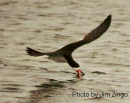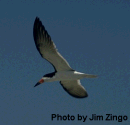Residents of Jamaica Bay
Black Skimmer (Rhynchops niger)



-
Rynchops niger is approximately 46 cm in length. Males tend to have a greater average mass (349 grams) than females (254 grams) (Dunning, 1993). Its dorsal side is black and its ventral side is white. The most conspicuous characteristic is its laterally flattened red bill. The lower mandible of the bill is about 1/3 longer than the upper mandible (Bull and Farrand, 1977). The male is substantially larger than the female (Burger and Gochfeld, 1992). Sexes can also be distinguished by the longer lower mandible and longer wing cord of the male (Erwin, 1977).
Status in Estuaries The black skimmer is a colonial species that often nests with other tern species (Hoopes et al., 1994). Breeding and foraging occurs in estuaries, with nests typically constructed on open spaces in beaches, salt marshes and dredge spoil islands. Nests are not elaborate; usually just a simple surface scrape. Typical clutch size is 4 eggs; maximum is 5 (Erwin, 1977). Young are semiprecocial (Ehrlich et al., 1988). The maximum lifespan recorded in nature is 20 years (Clapp et al., 1983).
Abundance and Range Breeding range extends from Massachusetts and Long Island south including Barren Island, through the coast of Florida. Laura Smith spotted them feeding by her boat.In winter months, this species can be found as far north as the Carolinas (Bull and Farrand, 1977). About 13,738 individuals were counted along the Atlantic Coast in the late 1970s (Spendelow and Patton, 1984).
Site Fidelity When reproductive success is high, this species often returns to the same location to nest, opting for alternate sites when reproduction has been poor (Erwin, 1977).
Ease of Census Simple
Feeding Habits As their name implies, this species obtains food by immersing its lower mandible into the water and skimming along the surface, allowing night time foraging (Burger and Gochfeld, 1990). Fish are the predominant food item brought to chicks. Species preferences include silversides and killifish. Less common items observed were bay anchovy, mullet, spot, and bluefish (Erwin, 1977).
Identification Tips:
- Length: 17 inches
- Sexes similar
- Skims surface of water with bill searching for prey
- Large bill with orange base and black tip; lower mandible longer than upper
- Short white tail with black center
- Very dark upperparts
- White forehead and underparts
- Dark upperwing with white trailing edge
- Pale underwings
- Red legs
- Duller above in winter
- Immatures are mottled above
Similar species:
None
Click rainbow above to see New York, New York forcast.